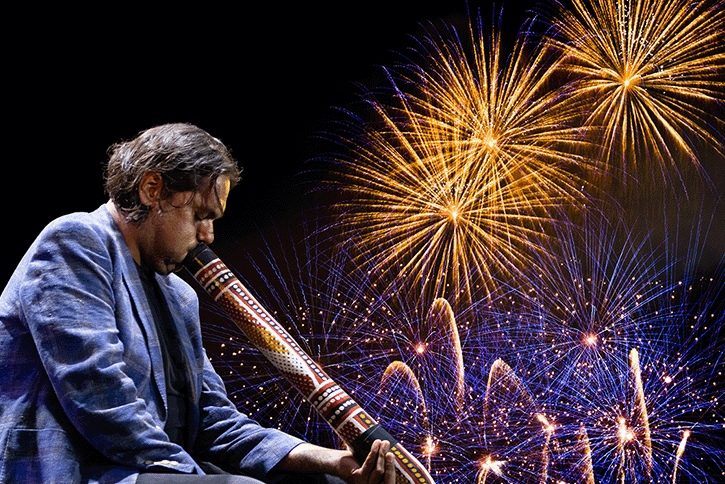The Elevator Pitch
A beloved under-the-stars Sydney Festival institution of modern and traditional classics by new, established and stratospherically celebrated composers performed by the Sydney Symphony and guest artists under the baton of conductor Benjamin Northey. Free, with thousands of music-lovers watching in the parklands of Parramatta, its spectacular finale sparkles with fireworks.
What’s different this year?
An extended line-up of performers including collaborations with virtuoso British-Indian-American sitar player, film composer and activist Anoushka Shankar; vocalist, guitarist and didgeridoo virtuoso William Barton; violinist and vocalist Veronique Serret; and song woman and lyricist Aunty Delmae Barton.
About the program
Impress anyone who’ll listen by memorising the following and whispering it authoritatively between musical pieces while stroking your chin. Feel the admiration.
World music superstar Anoushka Shankar enchants immediately with achingly beautiful selections from her Grammy nominated album Between Us, arranged by conductor and composer Jules Buckley. Known for breaking boundaries via her compositions and sitar-playing, and a respected musical performer since she was 13. Shankar, whose sister is singer Norah Jones, learnt her instrument under instruction from her father, sitar virtuoso Ravi Shankar.
Staying in the transportive realm comes William Barton and Veronique Serret’s co-composition Bush(fire) Requiem, arranged for orchestra by Erik Griswold. Blending the poetry of William’s mother Aunty Delmae Barton, this haunting and ethereal piece, inspired by the Australian landscape, melds the magic of Barton’s didgeridoo and guitar-playing with a message of looking after country and all Australians moving forward together as one people.
An anthem for all next, My Island Home, originally written by Neil Murray for George Rrurrambu (Burarrwanga), his bandmate and lead singer in the Warumpi Band, doubly fixed as an Australian classic after Christine Anu’s performance at the Sydney 2000 Olympics Closing Ceremony.
Then Benjamin Northey raises his baton to lead John Wiliams’s effervescently dynamic and triumphant ET the Extra-Terrestrial: Adventure on Earth, the American composer’s concert adaptation of the finale of Stephen Spielberg’s famous film. Interestingly, Williams (the most Oscar-nominated human alive) conducted this part of the soundtrack recording without syncing it to the film. Spielberg then re-cut the movie’s end to suit Williams's feel for his composition.
Next is Australian composer Ella Macens’s Release, a work commissioned by the Sydney Symphony as part of their 50 Fanfares Project, and inspired by the need to let things go in life. More letting go follows (via a rocket to the moon) with James Horner’s stirringly patriotic and heroic music for Ron Howard’s Apollo 13’s main titles.
The pace shifts, but stays skyward, with Johann Strauss II’s The Blue Danube, a swirling, twirling waltz swinging from quiet to furious. Forever connected to scenes in Stanley Kubrick’s 1968 film 2001: A Space Odyssey, sections have also accompanied a 1943 Daffy Duck cartoon, the animated film Horton Hears A Who! and Netflix series Squid Game.
Then, the concert’s triumphant finale - two movements from Russian composer Modest Mussorgsky’s Pictures at an Exhibition: Baba Yaga & The Great Gate of Kiev. Written in 1874, during a decline in health, Mussorgsky’s famous piano suite depicts a tour of ten art works by his late architect friend Viktor Hartmann.
Here the work’s most famous movements, the startling prowl of Baba Yaga - a depiction of a child-snatching witch in Russian folklore - and the resplendent, heart-swelling majesty of The Great Gate of Kiev, ring out.
All this topped by a spectacular fireworks display colouring the night sky above.
How to get there
Sydney Symphony Under the Stars takes place in Parramatta Park at a location called The Crescent, an outdoor event space formed around a bend of Parramatta River creating a natural amphitheatre.
Information on how to get to there by car or public transport can be found here, by calling 131 500 or visiting transportnsw.info.
If you are driving, the best places to park are the public parking stations on Hunter Street and Lang Street.
When to arrive
Whenever you fancy. It’s always recommended to come early to ensure a spot, get your bearings and settle in before the orchestra starts. The official program begins at 7.30pm but a variety of food trucks are open from 5pm. There are no gates, so you are welcome to come earlier than this.
Parramatta Park is an accessible venue. Check the Parramatta Park website for more info on access, limited mobility and hearing loop.
What to bring
The only seating provided is Parramatta Park’s (possibly rain-damp) grass and paved areas so pack picnic blankets, beanbags, low-level folding chairs or even folded newspaper inside a reusable bag. No upright camping chairs please, your neighbours behind need to see too.
You are very welcome to bring your own food and drink, including alcohol, but all drinking cups must not be made of glass.
Sydney Symphony Under the Stars goes ahead in all weather - bar a blizzard or actual raining meatballs - so bring rain coats, warm clothing and an umbrella. Leave the tent or beach cabana at home.
Feel free to take a zillion photos and, if you fancy, share them with us using #sydfest and #parrapark
Food and drink
Catering trucks will start serving from 5pm, with both food and drinks available. Why not make a night of it with a pre-show, festival-only $55 set menu feast at award-winning modern Pan-Asian restaurant Lilymu at Parramatta Square (a 15-minute walk away) which includes kingfish ceviche, chicken larb sando, chicken gyoza, wagyu beef massaman and more.
Tell us what you thought
We love to see you loving it. Share pics and vids of your evening on socials using the hashtags #sydfest #sydneysymphonyunderthestars and #parrapark







